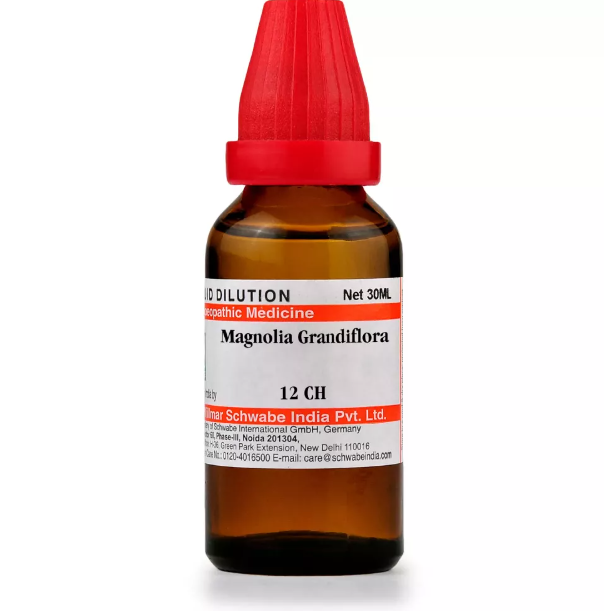MAGNOLIA GRANDIFLORA Q, 6C, 12C, 30C, 200C, 1M, 10M USES AND SYMPTOMS
 MAGNOLIA GRANDIFLORA
MAGNOLIA GRANDIFLORA
(Magnolia)
Magn-gr.
This drug prominently features rheumatism and cardiac lesions. Patients experience stiffness, soreness, and alternating pains between the spleen and heart, feeling tired and stiff with soreness when at rest. The pain is erratic and shifts around.
Heart: Patients feel chest oppression and can’t expand their lungs, sensing a large bolus of food distressing the stomach. There is a sensation of suffocation when walking fast or lying on the left side, along with dyspnea, crampy heart pains, angina pectoris, endocarditis, and pericarditis. Patients may tend to faint and feel as if their heart has stopped. There is also pain around the heart with accompanying foot itching.
Extremities: There is stiffness and sharp, erratic pains, especially worse in the joints. Feet itch, and there is numbness in the left arm with rheumatic pain in the clavicles and shooting pains in all limbs.
Modalities: Symptoms worsen in damp air, when lying on the left side, in the morning, and on first rising. They improve in dry weather, with motion, and during intermenstrual flow (compare with Ham., Bov., Bell, Elaps).
Dose: Third potency.
SYMPTOMS OF MAGNOLIA GRANDIFLORA
Heart:
Chest oppression and inability to expand lungs
Sensation of a large bolus of food distressing the stomach
Sensation of suffocation when walking fast or lying on the left side
Dyspnea (difficulty breathing)
Crampy heart pains
Angina pectoris
Endocarditis and pericarditis
Tendency to faint
Sensation of heart stopping
Pain around the heart with itching in the feet
Extremities:
Stiffness and sharp, erratic pains, especially in joints
Itchy feet
Numbness in the left arm
Rheumatic pain in clavicles
Shooting pains in all limbs
Modalities:
Worse in damp air, lying on the left side, in the morning, on first rising
Better in dry weather, with motion, and during intermenstrual flow
selection of the potency
Individualization:
- Homeopathy is based on the principle of treating the individual, not just the disease. The unique symptoms and characteristics of the person are crucial in determining the most suitable potency.
Intensity of Symptoms:
- The intensity of the symptoms guides the choice of potency. If the symptoms are intense and acute, a lower potency (e.g., 6C, 30C) might be considered. For chronic conditions with less intensity, higher potencies (e.g., 200C, 1M) may be appropriate.
Sensitivity of the Patient:
- Some individuals are more sensitive to homeopathic remedies, while others may require higher potencies. The practitioner considers the patient’s sensitivity when selecting the potency.
Acute vs. Chronic Conditions:
- Lower potencies are often used for acute conditions, while higher potencies may be considered for chronic or long-standing issues.
Previous Response to Potencies:
- The patient’s response to previous homeopathic treatments helps guide the choice of potency. If a particular potency has been effective in the past, it may be repeated or adjusted as needed.
Vital Force and Susceptibility:
- Homeopathy views illness as a disturbance in the vital force. The practitioner assesses the patient’s overall vitality and susceptibility to determine the appropriate potency.
Aggravation or Amelioration:
- The direction of the symptom response (aggravation or amelioration) after taking a remedy can influence the choice of potency.
Miasmatic Considerations:
- In classical homeopathy, the concept of miasms (inherited disease tendencies) is considered. The practitioner take this into account when selecting the potency.
Practitioner Experience:
- The experience and preference of the homeopathic practitioner play a role. Some practitioners may have success with certain potencies based on their clinical experience.
SAFETY INFORMATION
- Do not exceed the recommended dose by physician
- Keep out of the reach of children
- Store in a cool dry place away from direct sunlight
- Maintain half an hour gap between food/drink/any other medicines and homoeopathic medicine
- Avoid any strong smell in the mouth while taking medicine e.g. camphor, garlic, onion, coffee, hing
Medicine images use for reference only selection of homeopathic medicine depends on the individual’s specific symptoms and overall constitution. Moreover, homeopathy is a holistic system of medicine that treats the individual as a whole. In addition to addressing the physical symptoms, it takes into account the emotional and mental state of the person. Consequently, it’s crucial to consult with a qualified homeopathic practitioner for personalized treatment.
The information provided on this website is intended solely for educational purposes. Always seek the advice of your physician or other qualified health provider.
